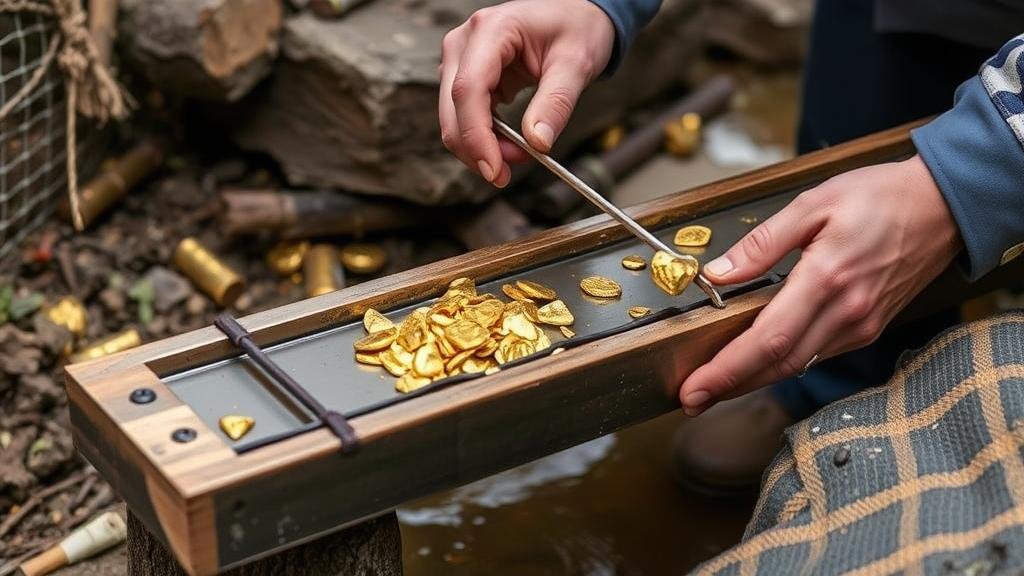Extracting Gold From Ancient Bench Deposits Using DIY Sluice Systems
Extracting Gold From Ancient Bench Deposits Using DIY Sluice Systems
The extraction of gold from ancient bench deposits is a task that has intrigued prospectors for centuries. These deposits, typically found at higher elevations and formed through geological processes, are often rich in fine gold particles. Utilizing DIY sluice systems can be an effective method for recovering this precious metal. This article delves into the principles, methodologies, and practical aspects of employing sluice systems for gold extraction from these alluvial deposits.
Understanding Ancient Bench Deposits
Ancient bench deposits refer to sediment layers that were once part of riverbeds, now elevated due to geological shifts. These deposits are usually characterized by:
- Fine gold particles distributed throughout the sediment.
- Compacted layers of gravel and sand formed by hydrodynamic forces.
Understanding the origin and composition of these deposits is crucial. For example, research indicates that rivers can transport gold for miles, resulting in the concentration of gold in specific locations due to changes in water flow and sedimentation patterns.
Working Principles of Sluice Systems
A sluice system is designed to take advantage of the density difference between gold and other materials. basic operation involves:
- Water flowing through a channel, creating a current.
- Material being fed into the sluice, where denser materials (like gold) are stratified and trapped.
To effectively capture gold, a sluice box must be designed with appropriate dimensions: typically, 4 feet in length and 12 inches in width can provide ample surface area for gold recovery. Also, riffles made from wood or metal create turbulence that helps separate gold from lighter materials by allowing it to settle in the grooves.
Materials for DIY Sluice Construction
Building a DIY sluice box requires specific materials that optimize performance:
- Wood or aluminum for the main body of the sluice box.
- Riffles, which can be constructed from metal sheets or purchased pre-made.
- Mesh screens to filter out larger debris and allow finer materials to pass.
An affordable example is using plywood for the box and lead flashing for riffles, which provides durability and weight necessary for effective capturing.
Setting Up the Sluice Box
Proper setup is crucial for maximizing gold recovery. The steps include:
- Location: Choose a site where ancient bench deposits are present, ideally near water sources.
- Angle: Set the sluice box at a slope of 5-10 degrees to enhance water flow without causing excessive turbulence.
- Water Flow: Ensure that the sluice box is submerged sufficiently to allow sediment to flow through effectively.
For example, adjusting the angle based on the water current can help maintain efficient operation. Observing how the materials interact with the current can lead to immediate adjustments that improve results.
Monitoring and Optimizing Performance
After setting up the sluice, monitoring its performance becomes necessary. Indicators of effective capture include:
- Consistent accumulation of heavier materials at the riffles.
- A relatively clear outflow of lighter materials.
Regular checks and adjustments can increase gold recovery significantly. Consider creating a data log to track the amount of material processed and the gold yield over time, which can help refine techniques based on observed trends.
Environmental Considerations
While the pursuit of gold can be enticing, it is essential to consider the environmental impact of sluicing activities. Techniques to minimize environmental disruption include:
- Avoiding over-excavation, which can lead to habitat destruction.
- Returning unused materials back to their original location.
- Using biodegradable materials when possible to reduce chemical footprint.
Compliance with local regulations is vital; check with governing authorities regarding permits or guidelines to avoid legal issues.
Real-World Applications
Across various regions, individuals and small-scale miners effectively utilize sluice systems to capitalize on ancient bench deposits. For example, in Californias Sierra Nevada, small miners have adopted DIY sluice systems with significant success, often sharing their findings and refining techniques through online forums.
Similarly, in Australia, miners utilize sluices to tap into these ancient deposits, reporting recovery rates that can vary from 0.5 to 1.5 grams per hour, depending on the system’s efficiency and the concentration of gold in the sediment.
Actionable Takeaways
Extracting gold from ancient bench deposits using DIY sluice systems can be a rewarding endeavor if approached with the right knowledge and tools. Key takeaways include:
- Understand the geological features of the target area and the nature of bench deposits.
- Construct an efficient sluice system utilizing appropriate materials and methods.
- Monitor and adjust operations based on performance to maximize gold recovery.
- Acknowledge and mitigate environmental impacts throughout the process.
By applying these principles and remaining responsive to local conditions, individuals can enhance their success in recovering gold from ancient deposits.


